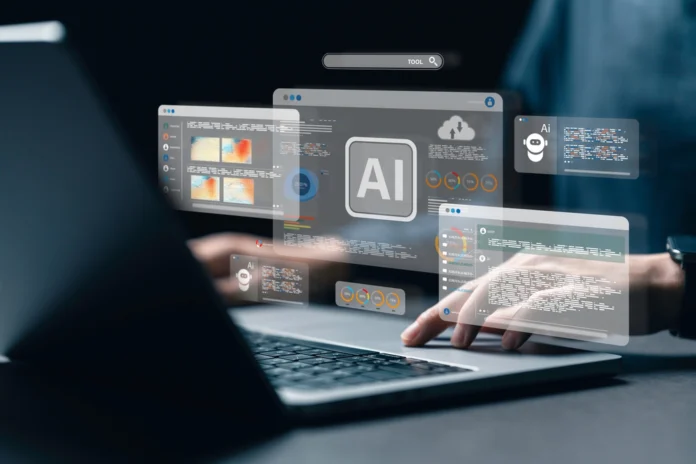AI-powered tools are substantially reshaping the educational terrain. They enhance personalized learning experiences by analyzing student performance and adapting curricula. Educational institutions are increasingly adopting AI for administrative efficiencies, automating tasks like admissions and attendance tracking. This technology nurtures student engagement and promotes customized learning paths. However, challenges remain, including ethical considerations and implementation obstacles. Understanding these dynamics provides perspective into the revolutionary impact of AI in education, highlighting the potential for innovative advancements on the horizon.
Highlights
- AI-powered tools personalize learning experiences by tailoring curricula to individual student performance and learning styles, enhancing engagement and retention.
- Administrative tasks are automated using AI, streamlining workflows and allowing educators to focus on student interaction and support.
- Intelligent tutoring systems leverage AI to respond to students’ emotional states, ensuring higher engagement levels in the learning process.
- AI-driven analytics enable adaptive learning platforms that predict optimal learning paths, allowing students to progress at their own pace.
- The integration of AI tools promotes inclusive learning environments, addressing skill gaps and enhancing overall workforce readiness for diverse student populations.
Market Growth and Future Projections
As the education sector increasingly welcomes technology, the market for AI-powered learning tools is positioned for outstanding expansion. Recent market trends indicate that the global AI in education market could soar from approximately USD 7.05 billion in 2025 to an astounding USD 112.30 billion by 2034, driven by a resilient compound annual growth rate (CAGR) of 36.02%. Alternative projections highlight potential growth even more extraordinary, with predictions ranging from USD 5.57 billion in 2024 to USD 21.13 billion by 2028 at a 39.6% CAGR. This surge is fueled by advancements in technology, increased investment in EdTech, and growing demand for personalized learning solutions. According to a Forbes Advisor survey, in fact, 56% of college students utilize AI to complete their assignments, emphasizing the widespread adoption of these tools. The future looks promising, ensuring that educational institutions can better meet the developing needs of learners worldwide. As AI chatbots are now available around the clock to assist students with homework, this further exemplifies the transformative role of technology in education.
Rising Adoption Rates Across Educational Institutions
With the rapid integration of artificial intelligence in educational settings, rising adoption rates across institutions are becoming increasingly evident. Approximately 54% of institutions are utilizing AI for curriculum design, while 52% automate administrative tasks. A significant 60% of administrators indicate active implementation, showcasing a systemic shift towards technology-driven architectures. Student engagement is also rising; 92% of UK students use AI tools, with many employing them weekly for research and assignments. However, this changes the conversation around academic integrity, as 18% of students admit to incorporating AI-generated text into their submissions, raising concerns about plagiarism and authorship. Moreover, 86% of students globally report using AI in their studies, underscoring the widespread reliance on these tools. Additionally, AI is being used across adaptive learning platforms, reflecting an increasing trend in personalized education. The digital divide remains an issue, disproportionately impacting non-STEM, lower-income, and female students, highlighting an ongoing need for equitable support in AI skills literacy.
Enhancing Personalized Learning Experiences
The integration of artificial intelligence in education not only enhances administrative efficiency but also substantially revolutionizes the learning experience itself. AI-driven analytics personalize learning by evaluating student performance and adjusting curricula to fit individual learning styles, resulting in improved learning outcomes. Hyper-personalized tutoring systems adeptly respond to students’ emotional states, ensuring higher levels of student engagement. With adaptive learning platforms predicting ideal learning paths, students can progress at their own pace, effectively closing skill gaps. As a result, the AI in personalized learning and education technology market reflects how retention rates soar as customized content meets diverse needs, showcasing the power of AI in creating customized educational experiences. Additionally, machine learning allows these AI systems to continually improve recommendations based on student data, further enhancing their effectiveness.
Consequently, AI promotes an inclusive and supportive learning environment, changing traditional classrooms into vibrant spaces where every student’s potential can flourish.
Improving Administrative and Operational Efficiency
AI technologies are revolutionizing administrative and operational efficiency in educational institutions by automating routine tasks and streamlining processes. Automated systems substantially expedite admissions, with AI handling application screening and reducing paperwork, promoting a more standardized approach across institutions. Additionally, AI optimizes workflows by automating attendance tracking, grading, and scheduling, allowing educators and administrators to focus on student engagement. Reports indicate that 60% of administrators leverage AI to enhance institutional operations, ultimately saving time and reducing manual labor. Moreover, AI chatbots provide round-the-clock support to students, enhancing their overall experience. 86% of students already use AI tools in their learning, demonstrating the growing reliance on technology to support education. By incorporating these AI-driven tools, educational institutions are ready to achieve streamlined operations and promote a collaborative environment, ultimately supporting both staff and students in their academic paths.
Addressing Ethical and Implementation Challenges
As educational institutions increasingly adopt AI-powered learning tools, they must traverse a complex terrain of ethical and implementation challenges. Ethical considerations arise from algorithmic discrimination risks that could disadvantage underrepresented groups, coupled with concerns about privacy due to extensive data collection practices. Additionally, schools face implementation obstacles like substantial IT infrastructure costs and the necessity for ongoing staff training. These issues complicate the integration of AI, as institutions must negotiate the intricacies of compliance with varying data protection standards. Moreover, the reliance on AI could potentially exacerbate equity gaps, promoting disparities in access to technology and limiting opportunities for human interaction crucial to student development. Addressing these challenges demands careful deliberation and proactive strategies. AI’s role is to augment the learning process, handling administrative tasks and freeing instructors to focus on teaching. Furthermore, a 67% increase in student engagement metrics in classrooms utilizing AI-enhanced learning tools highlights the importance of adopting such technologies responsibly. Institutions can leverage AI to create inclusive learning experiences that cater to students with diverse needs.
Key Stakeholders and Innovation Drivers
While traversing the changing terrain of educational technology, key stakeholders play a pivotal role in shaping the development and implementation of AI-powered learning tools, serving as an essential element. Educators contribute pedagogical knowledge and feedback, while AI developers provide innovative solutions, promoting collaborative development. Policymakers create structures that facilitate equitable AI integration in educational systems. Through structured stakeholder engagement, interdisciplinary partnerships address ethical and legal challenges, ensuring that AI tools remain effective and inclusive. The collaboration among these groups accelerates the adoption of revolutionary applications, such as personalized learning experiences and administrative efficiencies. Notably, the emergence of ChatGPT enhances the accessibility of educational resources, empowering students to seek information independently. In this shifting landscape, nurturing these relationships is essential for overcoming challenges and driving meaningful innovation in education, by utilizing specialized skills, and vital component, and promoting a revolutionary change, to reform, a dynamic landscape, and a developing structure. Additionally, AI integration must be accompanied by ongoing professional development to support educators in effectively utilizing these tools in their teaching practices.
The Future of AI in Educational Environments
The future of educational environments is increasingly intertwined with advancements in artificial intelligence, which promise to revolutionize the learning scenery substantially. Virtual classrooms will become increasingly sophisticated, utilizing intelligent tutors that adapt to students’ individual learning styles. As the EdTech market grows—projected to reach $404 billion by 2025—AI-driven tools will enhance personalized instruction, making learning more effective and accessible. Innovative platforms like Gradescope and Duolingo Max exemplify how AI promotes customized experiences, while also streamlining administrative tasks such as enrollment and grading. AI adoption accelerates worldwide indicates a commitment to integrating AI into education, ultimately enhancing workforce readiness and addressing skill gaps, thereby creating an inclusive and engaging learning terrain for all learners. This focus on personalized learning empowers students by allowing them to explore topics at their own pace and according to their interests. Furthermore, the rising number of AI-related regulations reflects a growing recognition of the need for responsible AI governance.
Conclusion
In summary, AI-powered tools are substantially reshaping the educational terrain, offering enhanced personalized learning experiences and improving operational efficiency within institutions. As adoption rates continue to rise and key stakeholders drive innovation, the future of AI in education appears promising. However, addressing ethical concerns and implementation challenges remains vital for successful integration. Ultimately, the evolution of these technologies will play a key role in redefining how teachers teach and students learn in an increasingly digital world.
References
- https://www.engageli.com/blog/ai-in-education-statistics
- https://www.enrollify.org/blog/ai-in-education-statistics
- https://aristeksystems.com/blog/ai-powered-learning-key-statistics-on-its-growing-impact/
- https://www.masterycoding.com/blog/landscape-of-ai-in-education
- https://www.cengagegroup.com/news/perspectives/2025/ais-impact-on-education-in-2025/
- https://www.precedenceresearch.com/ai-in-education-market
- https://www.open2study.com/statistics/ai-in-education/
- https://www.grandviewresearch.com/industry-analysis/artificial-intelligence-ai-education-market-report
- https://www.tekrevol.com/blogs/ai-in-education/
- https://market.us/report/predictive-ai-in-education-market/


